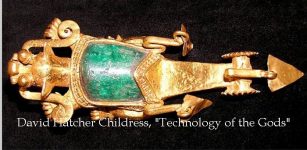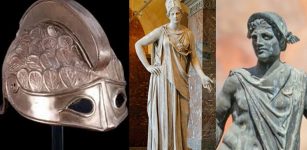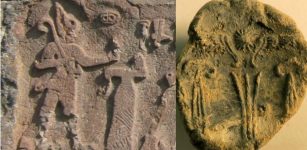Unraveling The Mystery Of The Phoenix Bird – Symbol Of The Sun And Eternal Rebirth Of Life
A. Sutherland - AncientPages.com - What is behind the story of Phoenix, the bird of immortality that rises from the ashes?
The Phoenix is known in various forms and names throughout the Middle and the Far East, the Mediterranean, and Europe. It is a symbol of resurrection.
Phoenix - Mythological Bird. In Greece, the phoenix rising from flames was the symbol of the First Hellenic Republic under Ioannis Kapodistrias, the Mountain Government and the Regime of the Colonels. Imge credit: Diafora - CC BY-SA 3.0
The name Phoenix may have come from the Greek phoînix and may be related to phoinos (blood-red).
In ancient Egypt, the Phoenix was called the "Lord of Jubilees" and was considered the ba (spirit) of the Sun God Ra. In Mesopotamia, the Phoenix is symbolized by the horned and winged solar disk. Alchemists used the Phoenix to represent the color red and the successful end of a process.
The medieval Hermeticists used the Phoenix as a symbol of alchemical transmutation.
Legends tell that the Phoenix had red and gold feathers, the rising Sun's color. It had a wonderfully melodious voice, which became mournful with approaching death. Other creatures were then so overcome by its beauty and sadness that they fell dead.
Ornament from a book of typographic specimens, 1870. Image source
From ancient texts, we learn that only one Phoenix could live at a time. Hesiod, the Greek poet, wrote that the Phoenix lived nine times the lifespan of the long-living raven. According to other sources, the Phoenix can live up to 97,200 years.
Tacitus (AD 56 – c. 120), a Roman historian and politician, is widely regarded as one of the prominent Roman historians by modern scholars. He said that "in the consulship of Paulus Fabius (AD 34), the miraculous bird known to the world by the name of the Phoenix, after disappearing for a series of ages, revisited Egypt. It was attended in its flight by various birds, all attracted by the novelty and gazing with wonder at its beautiful appearance."
Also, Herodotus' words are beautiful when he talks about the amazing Phoenix: "I have not seen it myself, except in a picture. Part of his plumage is gold-colored, and part crimson; and he is for the most part very much like an eagle in outline and bulk..."
 Egyptian Ba bird - the "ba," depicted as a human-headed falcon, was a spiritual aspect of one's personality. Image credit: Walters Art Museum - Public domain
Egyptian Ba bird - the "ba," depicted as a human-headed falcon, was a spiritual aspect of one's personality. Image credit: Walters Art Museum - Public domain
Pliny beliueved that there was to be only one Phoenix in the world, purple in color, with a golden head and a blue-pink tail, and with a crest of feathers on its head. He lived for 540 years, and then, it was time for him to built a nest of spices, in which he died. Tradition says that the Phoenix fed only on air, harming no other creature. It lived a solitary life in a faraway land, coming to a human-inhabited land only when it was ready to die. If the bird was injured, it possessed the power to heal itself.
When the Phoenix reaches the end of his life, it sets the nest and itself on fire and is burned to ashes. Shortly, the Phoenix rises again and begins its life anew. In some traditions, the new Phoenix gathers the old ashes and takes them to the Egyptian city of Heliopolis to offer them to the Sun God. The ashes laid on the Altar of the Sun are said to have the power to bring a dead man back to life.
When the Roman emperor Elagabalus (203-222) tried to become immortal, he dined off a bird of paradise, sent in place of a phoenix, but the substitute did not work. Instead, the emperor was murdered shortly afterward.
Death of the Phoenix burning in flames (medieval Aberdeen Bestiary). Image credit: Phoenix7777 - CC0 1.0
Unfortunately, there is little information about the Phoenix, the bird of flames.
Some people firmly believe that it is God's pet, let loose on the world now and again to give the people a glimpse of God's powers. Others swear that the Phoenix is a God, the incarnation of Foiros, bringing peace to the righteous and swift retribution to the evil and corrupt.
Yet another group says it is not more than a near-extinct animal, no different from a swan or dove. So far, scholars have been unable to trace the true origin of the Phoenix legend. It is believed, but not confident, that the legend came from the Orient and was adopted by Sun-worshipping priests of Heliopolis as an allegory of the Sun's daily setting and rebirth.
In Christianity, the resurrected Phoenix became a famous symbol for how Jesus Christ has risen from the grave.
The legend of this beautiful supernatural creature has survived for centuries. The Phoenix never died permanently. Legend says it existed when the universe was created.
It knows the secrets of life and reincarnation, knowledge even the most powerful gods do not possess.
Written by – A. Sutherland - AncientPages.com Senior Staff Writer
Updated on November 6, 2023
Copyright © AncientPages.com All rights reserved. This material may not be published, broadcast, rewritten or redistributed in whole or part without the express written permission of AncientPages.com
Expand for referencesReferences:
Nigg J. The Phoenix: An Unnatural Biography of a Mythical Beast
Bulfinch, Thomas. Bulfinch's Mythology
Pliny the Elder: Natural History, Books XXX
More From Ancient Pages
-
 Prehistoric Heavy Machinery Of The Ancient Times Or A Piece Of Jewelry?
Ancient Technology | Sep 12, 2018
Prehistoric Heavy Machinery Of The Ancient Times Or A Piece Of Jewelry?
Ancient Technology | Sep 12, 2018 -
 10 Incredible And Bizarre Ancient Cases Of Mass Hysteria
Featured Stories | Jul 14, 2015
10 Incredible And Bizarre Ancient Cases Of Mass Hysteria
Featured Stories | Jul 14, 2015 -
 Magical Cap Of Invisibility Worn By Athena, Hades, Hermes, And Perseus
Featured Stories | Mar 25, 2019
Magical Cap Of Invisibility Worn By Athena, Hades, Hermes, And Perseus
Featured Stories | Mar 25, 2019 -
 Little Known History Of Amazon’s Ashaninka People Studied By Researchers
Archaeology | Mar 21, 2023
Little Known History Of Amazon’s Ashaninka People Studied By Researchers
Archaeology | Mar 21, 2023 -
 Seven New Ancient Buddhist Caves – One With ‘A Harmika’ – Discovered In Mumbai
News | Jan 19, 2016
Seven New Ancient Buddhist Caves – One With ‘A Harmika’ – Discovered In Mumbai
News | Jan 19, 2016 -
 2,800-Year-Old Urartu Jars Uncovered In Eastern Turkey
Civilizations | Sep 9, 2015
2,800-Year-Old Urartu Jars Uncovered In Eastern Turkey
Civilizations | Sep 9, 2015 -
 1,000-Year-Old Palace Kitchen With A Cannonball Inside An Oven Found At Harput Castle In Elazig, Turkey
Archaeology | Aug 28, 2023
1,000-Year-Old Palace Kitchen With A Cannonball Inside An Oven Found At Harput Castle In Elazig, Turkey
Archaeology | Aug 28, 2023 -
 Spectacular 6th Century Sword With Runes Found In Anglo-Saxon Grave Near Canterbury In Kent
Archaeology | Dec 27, 2024
Spectacular 6th Century Sword With Runes Found In Anglo-Saxon Grave Near Canterbury In Kent
Archaeology | Dec 27, 2024 -
 Fascinating Discovery Of An Inhabited Underground World In Medieval Wales
Featured Stories | Mar 2, 2024
Fascinating Discovery Of An Inhabited Underground World In Medieval Wales
Featured Stories | Mar 2, 2024 -
 Ancient Stone Kitchens And Unlocking A Treasure Trove Of Culinary Secrets
Archaeology | Mar 31, 2025
Ancient Stone Kitchens And Unlocking A Treasure Trove Of Culinary Secrets
Archaeology | Mar 31, 2025 -
 Unusual Discovery Of A Viking Age Phallic Stone In Tystberga, Sweden
Archaeology | Jun 12, 2023
Unusual Discovery Of A Viking Age Phallic Stone In Tystberga, Sweden
Archaeology | Jun 12, 2023 -
 Huge, Stunning 2,000-Year-Old Marble Statues Restored In Ashkelon, Israel
Archaeology | Sep 17, 2024
Huge, Stunning 2,000-Year-Old Marble Statues Restored In Ashkelon, Israel
Archaeology | Sep 17, 2024 -
 Secrets Of Ark of The Covenant Revealed In Ancient Manuscript
Biblical Mysteries | Jul 19, 2014
Secrets Of Ark of The Covenant Revealed In Ancient Manuscript
Biblical Mysteries | Jul 19, 2014 -
 Migrants From Turkey And Greece Arrived In Britain Some 6,000 Years Ago
Archaeology | Apr 16, 2019
Migrants From Turkey And Greece Arrived In Britain Some 6,000 Years Ago
Archaeology | Apr 16, 2019 -
 Roskilde 6 – Longest Viking Ship Ever Discovered Was 37-Meters Long And Carried 100 Viking Warriors
Ancient History Facts | Dec 26, 2016
Roskilde 6 – Longest Viking Ship Ever Discovered Was 37-Meters Long And Carried 100 Viking Warriors
Ancient History Facts | Dec 26, 2016 -
 Watlington Viking Hoard May Re-Write History Of England
Archaeology | Dec 11, 2015
Watlington Viking Hoard May Re-Write History Of England
Archaeology | Dec 11, 2015 -
 DNA Of 10,000-Year-Old Luzio Solves The Mysterious Disappearance Of The Sambaqui Builders
Archaeology | Jul 31, 2023
DNA Of 10,000-Year-Old Luzio Solves The Mysterious Disappearance Of The Sambaqui Builders
Archaeology | Jul 31, 2023 -
 Ancient Clay Seals That Could Re-Write Hittite History Discovered In Kayalıpınar, Turkey
Archaeology | Sep 14, 2023
Ancient Clay Seals That Could Re-Write Hittite History Discovered In Kayalıpınar, Turkey
Archaeology | Sep 14, 2023 -
 On This Day In History: Captain James Cook Spotted The East Coast Of Australia – On Apr 19, 1770
News | Apr 19, 2017
On This Day In History: Captain James Cook Spotted The East Coast Of Australia – On Apr 19, 1770
News | Apr 19, 2017 -
 Rare Ancient Boomerang Collection Sheds New Light On Australia’s Past
Archaeology | Nov 4, 2021
Rare Ancient Boomerang Collection Sheds New Light On Australia’s Past
Archaeology | Nov 4, 2021



